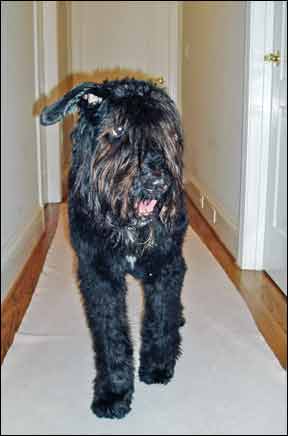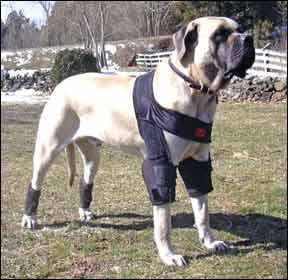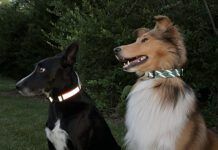In our March 2011 issue, we introduced you to a very small sampling of some of the neat “assistive equipment” options that are available to help our canine companions who have limited mobility or other physical issues. We received such a great response that we thought we’d share with you a few more finds that can help make life easier for you and your dog, particularly if he or she is aging or has orthopedic or neurologic issues.

288
Remember: the products mentioned here are only the tip of the iceberg. There are numerous companies making innovative assistive products; what we’re hoping to do here is to get you thinking about some of the possibilities!
No Slip Solutions
My husband and I purchased our home, in large part, to suit our dogs. What could be better than a one-level home with hard wood floors and no stairs to navigate? The single-level layout worked well as our dogs aged, but in their senior eyes, the hardwood floors have become a skating rink.
I dreaded the thought of buying carpet runners. They’d need a rug pad so they wouldn’t slip; they’d have to be vacuumed regularly; carpet is a breeding ground for fleas (especially here in the hot, humid south); and often, runners come with a dreadful chemical smell that takes a while to dissipate.
I was thrilled when I discovered a relatively inexpensive product called CarpetSaver, a lightweight, cotton blend, foam-backed terry runner that’s machine washable. I ordered a remnant roll and was able to cut the fabric easily with household scissors to varying lengths. Although this product will never make the cover of House Beautiful and is only available in four basic colors, I’ve been pleased with the quality, durability, and wash-ability of the product, along with the ease with which my elderly Bouvier, Jolie, now navigates through the house without missing a beat. I’ve gotten a return on my investment many times over! Suggested retail price is $20 and up; remnants and overstock sometimes available.
In some areas of our house, I’ve put down yoga mats for improved traction. They’re easy to keep clean; just pick up and shake out or vacuum. I recently learned that yoga matting is available in bulk rolls. A trainer friend lined the cargo area of her Honda Element with roll matting, making her English Mastiff very happy. The matting offers a great, grippy surface to walk on, but I’ve also found that guest dogs in our home gravitate to the mats as a comfy place to nap. Although I purchased Jolie’s yoga mats at a discount store for about $10 each, I recently found a 24″ x 104″ x ¼” roll of matting online for $125.
Front Limb Care
The signature product of DogLeggs Therapeutic & Rehabilitative Products is their Standard Adjustable DogLeggs. This product offers coverage, padding, and protection for elbow joints, and is regularly used to treat and prevent elbow hygromas – fluid-filled swellings at the point of one or both elbows, which can arise as the result of trauma or even from a dog lying for long periods of time on hard surfaces. In that case, over time, the point of the elbow bone traumatizes the soft tissue, causing inflammation and leading to the formation of a fluid-filled sac.

288
Standard Adjustable DogLeggs can also be used to help with a variety of other conditions, including elbow arthritis, decubital ulcers, pressure sores, and calluses, and a full length model for more coverage is available as well.
Consumers can measure their dogs themselves and order this product direct from the company; however, company spokesman John-Henry Gross believes that the best results are achieved when the client works with her dog’s veterinarian to measure and order the leggings. It’s also important to involve your veterinarian to be sure that what you’re looking at on your dog is a hygroma. Suggested retail: $108 (standard); $128 (full).
Hind-End Support
In our March issue, we talked about full body harnesses. In some cases, such as when a dog requires only hind-end assistance (i.e., post surgery), a full body harness might not be necessary. For those times, the Walkabout Back Harness (as seen on the facing page) is a great option. It’s made of a neoprene fabric with polypropylene webbing straps. It’s sturdy; has long, substantial handle straps (to save our backs!); and fits both male and female dogs.
To put the harness on, lay it flat on the floor and put the dog’s hind legs through two holes; the harness then wraps up over the dog’s back, closing with Velcro and buckles. I’ve had the chance to see the harness in action while being used to get a large dog (post-surgery, with two fractured hips) up and outside to eliminate, and it worked very well. While homemade works in some situations, I’ve seen firsthand that a product like this beats the old towel-under-the-belly, hands down. Suggested retail: $35 – $78.
Also in March, we mentioned one canine wheelchair, suggested by a veterinarian who specializes in canine rehab, as an example of the canine wheelchair-type products available. There are a number of other canine wheelchair makers, and each has products with unique features, benefits, and drawbacks. If your dog would benefit from a mobility cart, check out the offerings from the following companies to see what might work best for your dog, situation, and budget:
Doggon’ Wheels
888-7-DOGGON; doggon.com
Eddie’s Wheels
(888) 211-2700; eddieswheels.com
K9 Carts
(800) 578-6960; K9-carts.com
Healing Heat
Heat can offer our pets’ aching joints relief from pain, especially in cold, damp weather. The HipHug is a 100 percent cotton, rice-filled pad that you can heat in the microwave. What’s unique about the HipHug is that its cute bone shape is actually utilitarian: the way the pad is cut, it envelops and shapes to the dog’s hips and lower back nicely. The rice creates moist heat, easing joint pain and relaxing muscles.

288
As someone who spent this past winter getting up early to heat a pad to warm 14-year-old Jolie’s back and knees before her morning walk, I can attest that heat used properly can make a big difference in loosening up painful joints. Suggested retail: $13 – $25.
DogLeggs offers a similar product, the Buddy Bag, for hot or cold therapy.
How to Introduce New Equipment
Trainer and behaviorist Jean Donaldson posted a short video on YouTube of her Chow Chow, Buffy, gleefully accepting and wearing a stifle brace. In December 2010, then nine-year-old Buffy was diagnosed with a CCL (cranial cruciate ligament) tear. Donaldson chose to manage the injury conservatively, rather than subject Buffy to surgery, and opted for a stifle (knee) brace from OrthoPets. The brace helps prevent re-injury while the dog builds scar tissue and muscle around the injured knee.
In the video, Buffy was pretty happy to have Jean put on her brace. Donaldson spent time desensitizing Buffy to the brace before asking her to wear it. In fact, she first prepared Buffy for the casting procedure performed by Buffy’s veterinarian Anne Reed, DVM, which was required for fabrication of the brace. Dr. Reed was so impressed with Buffy’s cooperation during the casting that she asked Donaldson to write up a protocol for her to share with other brace clients. Donaldson graciously agreed to share it with us as well (see below).
After the casting, Donaldson prepared Buffy for the brace itself. Here’s how, in her words: “Show brace, then big pay-off (chicken). Touch leg with brace, then big pay-off. Hold brace against leg, then big pay-off. Add duration, paying off throughout. Add duration, pay off at end. Put brace on briefly, paying throughout. Put brace on, pay with intervals between installments. Put brace on, short walkies. Longer walkies.” She says it took only a few days for Buffy to willingly accept the brace but admits that the training she did for the casting likely sped up the process.
Buffy was rested for about eight weeks, then exposed to a gradual increase in length of walks and activity level, given supplements, and kept lean. Donaldson reports, “Buffy wears the brace for any activity where she might attempt a ‘sudden sprint.’ OrthoPets’ recommendation is for a dog to wear it for a maximum of eight hours a day. Buffy’s not a bouncing-off-the-walls kind of dog, so indoors she doesn’t wear it.” The plan is to gradually reduce the time Buffy wears the brace. See the video, “I’m Too Sexy for My Brace,” at tinyurl.com/buffybrace.
Lisa Rodier shares her home in Georgia with her husband and senior Bouvier, Jolie.






Is hipHug not around anymore? I’m very interested in it but it seems to not come up as a product anywhere.